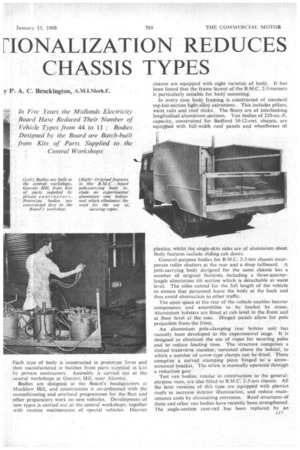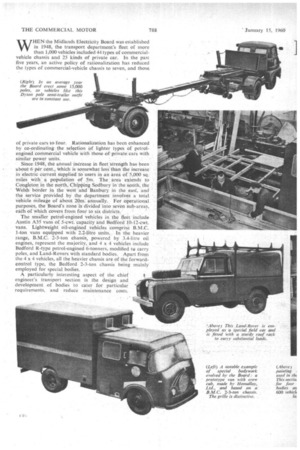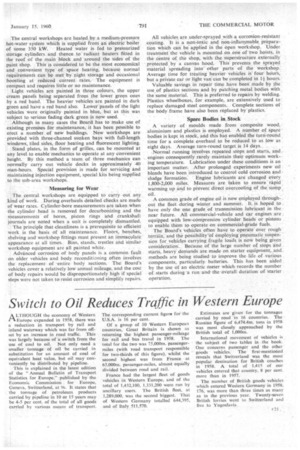FIONALIZAT I ON REDUCES CHASSIS TYPES
Page 55

Page 54

Page 56

Page 59

If you've noticed an error in this article please click here to report it so we can fix it.
y P. A. C. Brockington, A.M.I.Mech.E.
In Five Years the Midlands Electricity Board Have Reduced Their Number of Vehicle Types from 44. to 11 : Bodies . • Designed by the Board are Batch-built from Kits of Parts Supplied to the
-Central Workshops
WHEN the Midlands Electricity Board was established in 1948, the transport department's fleet of more than 1,000 vehicles included 44 types of commercialvehicle chassis and 25 kinds of private car. In the past
five years, an active policy of rationalization has reduced the types of commercial-vehicle chassis to seven, and those
of private cars to four. Rationalization has been enhanced by co-ordinating, the selection 'of lighter types of petrolengined commercial vehicle with those of private cars with siinilar power units.
Since•1948, the annual increase in fleet strength has been about 6 per tent, Which is somewhat less than the increase in electric current Supplied to users in an area of 5,000 sq. Miles With.. a population of .5m. The area extends to Congleton in the north, Chipping Sodbury in thesouth, the Welsh • bcirder in the west arid Banbury in the east, and the Service provided by the department involves a total Vehicle Mileage of about 20m: annually. For operational purposes, the Board's zone is divided into seven sub-areas,
each Cif Which covers from four to six districts. •
The smaller petrol-engined vehicles in the fleet include Austin A35 vans Of .5-cwt: capacity and Bedford 10,12-cwt. vans. Lightweight oil-engined vehicles comprise B.M.C. 1-ton vans equipped with 2.2-litre Units. In the heavier range, B.M.C. 2-3-ton chassis, powered by 3.4-litre oil engines, represent the majority, and 4 x 4 vehicles include Bedford R-type petrol-engined 6-tonners, modified ty carry poles, and Land-Rovers with standard bodies. Apart from the 4 x 4 vehicles, all the heavier chassis are of the forwardcontrol type, the Bedford 2-3-ton chassis being mainly employed for special bodies.
A particularly interesting aspect of the chief 4 engineer's transport section is the design and development of bodies to cater for particular requirements, and reduce maintenance costs.
Each type of body is constructed in prototype form and then manufactured in batches from parts supplied in kits by private contractors. Assembly is carried out at the central workshops at Gorcott Hill, near Alcester.
Bodies are designed at the Board's headquarters at Mucklow Hill, and construction is co-ordinated with the reconditioning and overhaul programmes for the fleet and other preparatory work on new vehicles. Development of new types is carried out at the central workshops. together with routine maintenance of special vehicles. Heavier chassis are equipped with eight varieties of body. It has been found that the frame layout of the B.M.C. 2-3-tonners is particularly suitable for body mounting.
In every case body framing is .constructed of standard top-hat-section light-alloy extrusions. This includes pillars, waist rails and roof sticks. The floors are of interlocking longitudinal aluminium sections. Van bodies.of 210-cu.-ft. capacity, constructed for Bedford 10-12-cwt. chassis, are equipped with full-width roof panels and wheelboxes of
plastics, whilst the single-skin sides are of aluminium sheet. Body features include sliding cab doors.
General-purpose bodies for B.M.C. 2-3-ton chassis incorporate roller shutters at the rear and a drop tailboard. A pole-carrying body designed for the same chassis has a number of original features, including a three-quarterlength aluminium tilt section which is detachable at waist level. The sides extend for the full length of the vehicle to ensure that personnel leave the body at the back and thus avoid obstruction to other traffic.
The open space at the rear of the vehicle enables heavier components and assemblies to be loaded by crane. Aluminium bolsters are fitted at cab level in' the front and at floor level at the rear. Hinged panels allow" for pole projection from the front.
An aluminium pole-clamping rear bolster unit has recently been developed to the experimental stage. It is designed to eliminate the use of ropes for securing poles and to reduce loading time. The structure comprises a slotted 'transverse therriber,mounted above the bolster, to which a number of screw-type clamps can be fitted.. These comprise a .curved clamping piece hinged US a screw mountedbracket. The screw is manually operated through
a reduction gear. .
Test van bodies, similar in construction to the generalpurpose vans, are also fitted to B.M.C. 2-3-ton chassis. All the later versions of this type are equipped with plastics foofs to increase interior illumination, and reduce maintenance costs by eliminating corrosion. Roof structures of these and other van bodies have recently been strengthened. The angle-section cant-rail has been replaced by an extrusion which has a radiused section integral with a lower channel-section member, which mates with the pillars.
These top-hat members face outwards. The longitudinals also face outwards and are slotted to receive the pillar sections. Extensive use is made of gusset plates. Framework and panelling are assembled with hollow and solid rivets and a smaller number of bolts with self-locking nuts.
Bodies for the Bedford 4 x 4 chassis are of the threequarter-length tilt type with full-length sides and plastics roofs. Aluminium tipper bodies are designed for use with a 2-ton chassis and are operated by single front-of-body rams. These bodies, which are rarely loaded to full capacity, carry loads of ashes and other abrasive and corrosive materials. The aluminium structure offers a far greater resistance to abrasion and corrosion than the standard type and is more easily repaired.
Increased comfort for the crews of constructicg-gang 2-3-ton vehicles is provided by a Hotnalloy prototype cab of aluminium and plastics. A two-passenger seat is fitted beside the driver and there is a full-length bench seat at the rear. It is a notable example of an improved type of special body evolved by the department. Fittings include a heater-demister unit which is a feature now being adopted throughout the fleet. This equipment is regarded as a necessity to promote safety as well as comfort, particularly as many of these vehicles operate a 24-hour service during winter arid summer. • On average, the Board erects 15,000 poles a year, and in many instances a post-hole borer is employed. This equipment was originally mounted on American. 6 x 6 petrolengined chassis, but these are approaching the end of their economic life. Vehicles for this work require good traction capabilities for cross-country operations; and replacement of the old chassis at first presented a 'difficulty. Eventually, a satisfactory solution was evolved by converting a B.M.C. four-wheeler into a 6 x 4 chassis with a mean wheelbase of 13 ft. 6 in.
This was achieved by reducing the length of the chassis and fitting a supplementary frame with a. Hendrickson swinging-beam bogie with rubber suspension. Both axles incorporate differential locks, which *greatly increase the available traction. The aluminium body carries a special mounting frame for the oil-engined borer. This can easily be removed to allow the chassis to be employed for other work.
Various types of aluminium body for fourand twowheeled trailers have also been developed. They include c18
a technician's four-wheeled trailer which is 15 ft. long with
a floor height of 2 ft. 3 in. It is fitted with fresh-water tanks, drain tanks and heating equipment and is normally employed for prolonged site work. Smaller close-coupled ex-American Army four-wheeled trailers, with steel bodies, are being replaced by aluminium-bodied types. They are fitted with standard drawbar towing attachments and servo brakes in place of the electrically operated braking system of the American trailers.
Jointers' standard two-wheeled trailers with composite bodies are sometimes equipped with light-alloy bodies designed by the department. Tests on one type, utilizing Bramber rubber suspension units, have been carried out at the Motor Industry Research Association's proving ground in co-operation With a leading tyre manufacturer. Results have so far been most promising.
Maintenance is organized on a time schedule divided into weeks and multiples of a week. Daily inspections of fuel levels and so on by drivers are followed by weekly attention from the automatic washing machines in the depot. Greasing is done fortnightly, and inspections of mechanical and electrical components are made by qualified mechanics at fourweekly intervals.
Until recently a preventive-maintenance docking plan was arranged at intervals of 40 weeks at the sub area repair depots. Lighter vehicles were completely overhauled every three years at the central repair depot. However, because of the improved standard of maintenance it has been possible to extend the 40-week interval to 52 weeks and the overhaul interval to four years. Heavier vehicles are completely overhauled every six years.
A particular advantage of the time-interval maintenance schedule is its ready co-ordination with the purchasing cycles. It eliminates unnecessary immobilization of vehicles and increases fleet utilization. Schedules are based on 13 four-week periods, and by the use of charts the maintenance programme is planned to fit in with purchasing arrangements.
Smart appearance is given top priority and painting costs are a prime consideration, involving a detailed investigation of the latest methods. All painting is carried out at the central depot and more than 600 vehicles were painted last year—the Majority in three colours. The labour team in the spray shop comprises three operatives, who work an eight-hour day shift. The paint shop capacity is about four average-sized bodies, and internal movement is facilitated by mounting on light-alloy carriers. ..
This high rate of body finishing, at low cost, is made possible by using the hot-spray technique, with Vulflo paint. Equipped with a battery of electric heaters, the paint shop can be heated to working temperature with an insignificanttime lag. This normally represents a temperature rise of around 30° F. A plenum system enables air to be drawn from an external inlet or from the interior of the workshop. The central workshops are heatedly a medium-pressure hot-water system which is supplied from an electric boiler of some 350 kW. Heated water is fed to pressurized storage cylinders and thence to radiant heaters fitted in the roof of the main block and around the sides of the paint shop. This is considered to be the most economical and convenient type of space heating, because normal requirements can be met by night storage and occasional boosting at reduced current rates. The equipment is compact and requires little or no maintenance.
Light vehicles are painted in three colours, the upper cream panels being separated from the lower green ones by a red band. The heavier vehicles are painted iii dark green and have a red band also. Lower panels of the light vehicles were originally painted in blue, but as this was subject to serious fading dark green is now used.
Although in many cases the Board has to make use of existing premises for maintenance, it has been possible to erect a number of new buildings. New workshops are provided with three-channel sunken bays with full-length windows, tiled sides, floor heating and fluorescent lighting.
Stand plates, in the form of grilles, can be mounted at any level to enable"mechanics to operate at any convenient height. By this method a team of three mechanics can normally carry out vehicle docks in approximately 40 man-hours. Special provision is made for servicing and maintaining injection equipment, special kits being supplied to the sub-area workshops.
• Measuring for Wear . . .
• . The central workshops are equipped to carry out any kind of work. During overhauls detailed checks are made of wear rates. Cylinder-bore measurements are taken when the cylinder head is removed for decarbonizing and the measurements of bores, piston rings and crankshaft journals are noted when a unit is completely dismantled.
The principle that cleanliness is a prerequisite to efficient work is the basis of all nriaintenance. Floors, benches, shelving and workshop fittings must present an immaculate appearance at all times. Bins, stands, trestles and similar workshop equipment are all painted white.
Advanced corrosion of body panels is .a common fatilt on older vehicles and body reconditioning often involves the replacement of -entire body sections. The Board's vehicles cover a relatively low annual mileage, and the cost of body repairs would be disproportionately high if special steps were not taken to resist corrosion and simplify repairs.
All vehicles, are under-sprayed with a corrosion-resistant coating. It is a non-toxic and non inflammable preparation which can be applied in the open workshop. Under treatment the vehicle is mounted on one of two hoists, in the centre of the shop, with the superstructure externally protected by a canvas hood. This prevents the sprayed material spreading into other parts of the workshop. Average time for treating heavier vehicles is' four hOurs, but a private car or light var(can be completed in 11 hours.
Valuable savings in repair time have been made by the ' use,of plastics sections and by patching metal bodies with the same material. This is preferred to repairs by welding. Plastics wheelboxes, for example, are extensively used to' replace damaged steet components. Complete sections of the body frame have also been replaced by plastics.'
Spare Bodies in, Stock A variety of moulds made from composite wood, • aluminium and plastics is employed. A number of Spare bodies is kept in stock, and this has enabled the turn round time for a complete overhaul to be reduced to as low as
eight days. Average turn-round target is 14 days.. .
• Normal running involves repeated stops and starts, and engines consequently rarely maintain their optimum working temperature. Lubrication under these conditions is an important matter. After prolonged experiments new oil blends have been introduced to control cold corrosion and sludge formation. Engine lubricants are changed every 1,800-2,000 miles. Measures are taken to ensure rapid warming up and to prevent direct overcooling of the sump oil.
A common grade of engine oil is now employed throughout the fleet during winter and summer. It is hoped to have only the one grade of transmission lubricant in the • near future. All commercial-vehicle and car engines are equipped with low-compression cylinder heads or pistons to enable them to operate on commercial-grade fuels.
The "Board's Vehicles often have to operate over rough _terrain, and the possibility'of employing pneumatic .stispension for vehicles carrying fragile loads is now being given consideration: Because of the large number of stops and starts, heavy' demands are made on starter equipment, and methods are being studiedto improve the life of •various components, particularly batteries. This has been aided by the use of an electric meter which records the nuniber of .starts during-a run and' theoVerall duration of starter . operation.












































































































